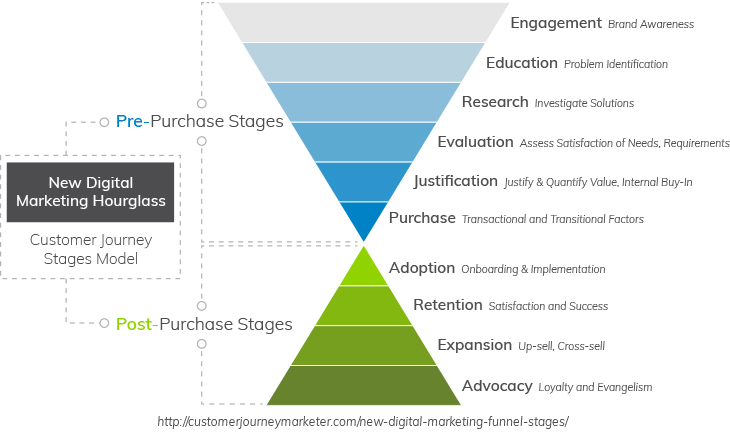When researching our 2021 Communication Trends Guide, we made a fascinating discovery: marketing is getting involved in after-sales support. This is unusual – but, when exploring it further, it makes excellent business sense. Here’s how marketing can improve your client experience and customer retention by actively communicating beyond the sale.
New Digital Marketing Hourglass
It turns out, marketers may have got the sales funnel only half right. A customer journey doesn’t end with a sale – that’s just the start. The actual conversation only ends when a client leaves; something no business wants.
That means, without a seamless journey from sale to onboarding and ongoing support, many organisations are bowing out of most of the client conversation. According to Forrester’s 2018 Customer Experience Index, not a single US brand had, at the time, shown leadership in this space. Forrester’s 2020 research shows that this has improved dramatically since then. This suggests that the trend is growing, businesses are taking it seriously, and competition in this space is growing too.
The digital marketing funnel should actually look more like an hourglass:

The Business Value of Retention
This may seem obvious, but the stats above show that many companies are still not getting this right. Because of the long-term value of an existing client, focussing solely on attaining new clients is unsustainable. To give you an idea of just how potent this is, here are some of the stats we found:
- 72% of buyers and decision-makers report engaging with a vendor over the last three months before they purchase; a number that plummets to 34% after sale and only increases by 2% when contracts need to be renewed. (LinkedIn)
- 68% of sales come from existing customers. (Simple CRM)
- About 20% of customers are lost by an average business annually, due to lack of cordial relationship. (Marketing Wizdom)
- Attracting new customers can cost five times more than retaining current ones. (Forbes)
- Increasing customer retention rates by 5% can increase profits by 25% to 95%. (Forbes)
Bottom line? LinkedIn summarises it perfectly: “Your customers hear from you much more before they become your customers than after — and the implication becomes that they are more important as prospects than as customers.”

How to Market Beyond the Sale
Enough about the why. Let’s get to what you can do about it. Here are some tips for how marketing and sales teams can work to support client retention:
- Collaborate Across Departments
If you haven’t already, start collaborating regularly and strategically between your marketing, sales, and client support departments – they’re all involved in your brand’s customer journey. The more aligned they are to each other, the tighter and smoother the journey can be from introduction to ongoing customer care.
According to LinkedIn:
“In this landscape, post-sales support should be the rule, not the exception…. Customer experience and nurturing, then, has to be everyone’s responsibility. This requires tearing down silos across departments. You have to do the hard cultural and process work of setting up those pipelines, with processes that are regular, re-occurring and productive.”
- Create Marketing Content for Sales
This is something we do a lot in Everlytic. The marketing department creates content for multiple departments across the company, including sales and client relationship management. As marketing teams are usually in charge of brand identity, it makes sense for them to create the content typically used throughout the customer journey.
As LinkedIn says:
“Marketing-supported sales enablement is essential to closing the deal, but it’s also essential to maintaining it… If sales can continuously add value, they are more likely to build positive momentum.
Think: Are there new product features available? Has one of the features become relevant to new industry trends? Is one customer using your product to achieve great results in a way that can be replicated and shared through a mini-case study? Offer a spin on the same kind of thought leadership you use in your pre-sale marketing content strategy.”

- Personalise Your Post-Sale Content
Hyper-personalisation is something many marketing departments use – because it works! And this goes for everyone else you communicate with too – especially existing customers who you typically have more data on.
Consider, for instance, how Netflix does it: consistently sending push notifications and email recommendations based on the content you’ve already shown interest in. This is a highly efficient and effective use of data to adapt the journey based on what the customer does – automatically. Adding value and enticing the customer to keep coming back for more.
- Merge Customer Journey Department KPAs
From the time a customer learns about who you are to the point when they’re a client, they’re involved in an ongoing conversation run by multiple departments. And, ultimately, all these departments want the same thing: to facilitate an excellent customer experience. Why not merge their KPAs? From the client’s side, it’s one conversation – one goal – why not on yours too?
The world is changing rapidly – and your clients are changing with it. Keep the conversation going with the same commitment you started it with, so you can respond immediately when they do.
Get Your Communication on Trend in 2021
With post-2020’s ‘new normal’, business communication has changed. What impact do these changes have on your business in 2021? In our guide, Communication in the ‘New Normal’: How to Prepare for 2021, we explore the trends that have emerged from this new way of life and what that means for you.



